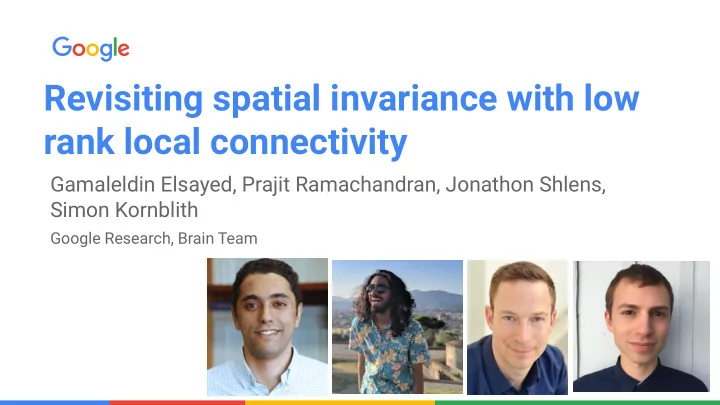

Revisiting spatial invariance with low rank local connectivity Gamaleldin Elsayed, Prajit Ramachandran, Jonathon Shlens, Simon Kornblith Google Research, Brain Team Confidential & Proprietary Confidential & Proprietary
Is spatial invariance a good inductive bias? ● Convolutional architectures perform better than locally connected on computer vision problems. ● Both convolution and local connectivity assume local receptive fields as an inductive bias. ● Distinction between the two is requiring spatial invariance in convolution. ● Spatial invariance: local filter bank is shared and applied equally across space. Image from https://opidesign.net/landscape-architecture/landscape-architecture-fun-facts/
Is spatial invariance a good inductive bias? Image from https://opidesign.net/landscape-architecture/landscape-architecture-fun-facts/
Low rank local connectivity (LRLC) Spatially invariant
Low rank local connectivity (LRLC) Spatially invariant Spatially varying
Low rank local connectivity (LRLC) Spatially invariant Spatially partially-invariant Spatially varying ● Basis set of K local filter banks (controls the degree of relaxation of spatial invariance): E.g. 3x3 LRLC layer with rank 2 C_in*C_out 0.8 Image F (1) C_in*C_out 0.2 F (2) F (1, 1)
Types of LRLC layers Fixed LRLC Input-dependent LRLC Fixed basis set of K filter banks. Fixed basis set of K filter banks. Fixed combining weights . Combining weights are generated by a simple neural network . Learnable parameters: Learnable parameters: K filter banks and combining weights. K filter banks and the simple network parameters.
Experiments ● Datasets: ○ MNIST. ○ CIFAR-10. ○ CelebA. ● Network: 3 layer network with 3x3 filter sizes and 64 channels (global average pooling with fully connected). ● No augmentation or regularization to focus on architecture effects. ● We also demonstrate the feasibility of applying LRLC to large scale problems by running experiments on ImageNet.
Spatial invariance may be overly restrictive Accuracy increases over convolution baseline as we relax spatial invariance consistent with our hypothesis.
Spatial invariance may be overly restrictive Low rank local connectivity outperforms wide convolutions, locally connected layers, and coord conv. Optimal rank is dataset dependent and is higher for more aligned data (eg CelebA) than less aligned data (CIFAR-10).
Input-dependent LRLC is a better inductive bias for datasets with less alignment Less aligned dataset: Input-dependent LRLC suits CIFAR-10 better than fixed LRLC. More aligned dataset: Fixed LRLC suits CelebA better than input-dependent LRLC.
Input-dependent LRLC is a better inductive bias for datasets with less alignment Misaligned examples in translated CelebA impact the fixed LRLC model performance but not the input-dependent LRLC.
Visualization of learned combining weights Filter bank 1 Filter bank 2 w (i, j) 3x3 LRLC layer with rank 2 C_in*C_out w (i, j) F (1) F (i, j) w (i, j) C_in*C_out F (2) 1-w (i, j) w (i, j)
Feasibility of the application of LRLC to large scale problems ● Locally connected layers are prohibitively expensive to apply to large scale problems. ● Parameter count of the LRLC layer scales only with rank, making it feasible to apply to large scale problems. ● We demonstrate this feasibility by applying LRLC to ResNet-50 on ImageNet 224x224.
Conclusions ● We design a new layer (LRLC) that can parametrically adjust the degree of spatial invariance to test whether spatial invariance is a good inductive bias. ● Main takeaway: we demonstrate that spatial invariance in convolutional layers may be an overly restrictive inductive bias. ● Unlike locally connected layers, parameter count of the LRLC layer scales only with rank, making it feasible to apply to large scale problems. ● Future direction: applications of LRLC to other computer vision problems.
Acknowledgements We thank the following for useful discussions and helpful feedback on the paper: Jiquan Ngiam Pieter-Jan Kindermans Jascha Sohl-Dickstein Jaehoon Lee Daniel Park Sobhan Naderi Max Vladymyrov Hieu Pham Michael Simbirsky Roman Novak Hanie Sedghi Karthik Murthy Michael Mozer Yani Ioannou
Questions? Thank you! Paper: https://arxiv.org/abs/2002.02959 Code: https://github.com/google-research/google-research/tree/master/low_rank_local_connectivity Confidential & Proprietary
Recommend
More recommend